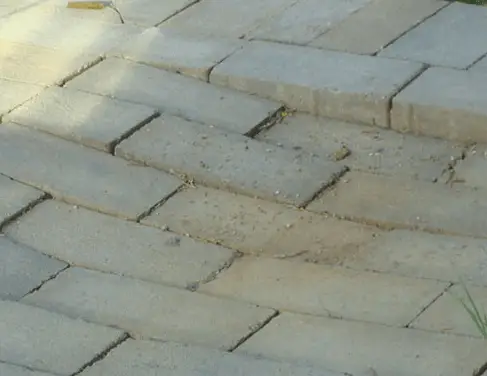Patios enhance exterior beauty of a home and also form a place to spend your evenings enjoying a cool breeze or hosting a barbecue party. Stone and brick pavers are popular materials for construction of a patio due to their durability and availability.

However, with time pavers or patio slab may sink to form a low spot. Let us look at the reasons why your pavers are sinking and how to fix the mess.
Why does my patio sink?
Besides being unsightly, uneven or sunken patio stones can cause drainage problems, tipping hazard or cause premature reinstallation. Before we look at how to fix, here are possible reasons for a sinking patio.
1. Unstable ground
Before laying patio pavers on dirt, ensure the base is compact and stable. Loose soil has to be removed to a good depth before gravel is compacted in. This is followed by a layer of sand that creates a flat and even surface for laying of pavers. Failure to provide a steady base will automatically lead to sinking of your patio after installation or in due time.
Absence of paver sand or failure to use critical tools like edger and level can also result to shifting of pavers or gaps after installation. Unstable ground can also be caused by expansion and contraction of soil around due to change in moisture content.
2. Water erosion
Underlayment of sand and gravel can get removed by water usually during heavy rains. Additionally, when joint sand is totally washed away by running water, pavers become unstable and may begin to dip. Erosion can also take place during cleaning with a pressure washer. Strong winds can also blow away important sand from your patio.
A good drainage is important in fighting soil erosion. Controlling of surface run off and growing of ground cover plants can help in protecting your patio. Further measures include replacing of joint sand after pressure washing to keep the stones bonded in position.
3. Tree Roots
Large roots from trees and shrubs beside your home are another reason for sinking of your patio. When the roots penetrate through the base, they cause massive soil movement that shows up inform of deep spots and uneven surface. Dead roots also tend to cause soil to collapse when they decompose.
While it is almost irresistible to plant trees and other shrubs around your home, you will have to be strategic on type of plants to grow and to consider their distance from the patio.
4. Earthquake
Although rare, earthquakes can cause small to massive land shifting that can impact on your patio. This a natural phenomenon that can also pose a great danger to your entire home and family. If you live in areas affected by natural landslides and earthquakes, the best thing to do is to relocate to a safer area.
How to Fix Sunken Pavers
You can fix a sunken patio yourself or hire a professional especially for a larger problem. Here are the steps for repairing a low spot on a paver patio:
- Remove the affected stone or brick paver and possibly others next to it using a flat headed tool
- Dig down into the ground base and try to find out what is causing the dip
- Add gravel for a stable and well drained base and level out with sand
- Return the patio stones back to their positions
- Fill the gaps between the stones using sand and spread with a broom
For whatever reason your patio is sinking, early fixing is important before the problem becomes enormous. For a more stable and lasting patio, ensure weeds are controlled, stains are removed and washing is done using the right cleaner. Pavers can last up to 30 years when properly installed and maintained.